Learn about Ocean Dumping
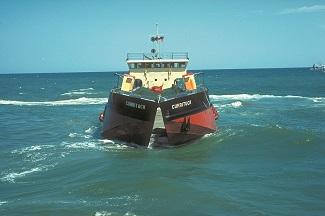 On this page:
On this page:
- What was dumped into the ocean before 1972?
- What is the Marine Protection, Research, and Sanctuaries Act?
- How does EPA implement the MPRSA?
- Why is regulating ocean dumping important? How does EPA help protect the ocean?
- Besides EPA, what are other federal agencies’ roles with respect to ocean dumping?
- What materials are dumped into the ocean today?
- What materials cannot be dumped into the ocean?
- Can wastes be incinerated at sea?
- How have ocean protections improved since enactment of the 1972 MPRSA?
- Where can I learn more about EPA’s Ocean Dumping Management Program?
What was dumped into the ocean before 1972?
In the past, communities around the world used the ocean for waste disposal, including the disposal of chemical and industrial wastes, radioactive wastes, trash, munitions, sewage sludge, and contaminated dredged material. Little attention was given to the negative impacts of waste disposal on the marine environment. Even less attention was focused on opportunities to recycle or reuse such materials. Wastes were frequently dumped in coastal and ocean waters based on the assumption that marine waters had an unlimited capacity to mix and disperse wastes.
Although no complete records exist of the volumes and types of materials disposed in ocean waters in the United States prior to 1972, several reports indicate a vast magnitude of historic ocean dumping:
- In 1968, the National Academy of Sciences estimated annual volumes of ocean dumping by vessel or pipes:
- 100 million tons of petroleum products;
- two to four million tons of acid chemical wastes from pulp mills;
- more than one million tons of heavy metals in industrial wastes; and
- more than 100,000 tons of organic chemical wastes.
- A 1970 Report to the President from the Council on Environmental Quality on ocean dumping described that in 1968 the following were dumped in the ocean in the United States:
- 38 million tons of dredged material (34 percent of which was polluted),
- 4.5 million tons of industrial wastes,
- 4.5 million tons of sewage sludge (significantly contaminated with heavy metals), and
- 0.5 million tons of construction and demolition debris.
- EPA records indicate that more than 55,000 containers of radioactive wastes were dumped at three ocean sites in the Pacific Ocean between 1946 and 1970. Almost 34,000 containers of radioactive wastes were dumped at three ocean sites off the East Coast of the United States from 1951 to 1962.
Following decades of uncontrolled dumping, some areas of the ocean became demonstrably contaminated with high concentrations of harmful pollutants including heavy metals, inorganic nutrients, and chlorinated petrochemicals. The uncontrolled ocean dumping caused severe depletion of oxygen levels in some ocean waters. In the New York Bight (ocean waters off the mouth of the Hudson River), where New York City dumped sewage sludge and other materials, oxygen concentrations in waters near the seafloor declined significantly between 1949 and 1969.
What is the Marine Protection, Research and Sanctuaries Act?
In October 1972, Congress enacted the Marine Protection, Research and Sanctuaries Act (MPRSA), sometimes referred to as the Ocean Dumping Act, declaring that it is the policy of the United States to regulate the dumping of all materials which would adversely affect human health, welfare or amenities, or the marine environment, ecological systems or economic potentialities.
The MPRSA implements the requirements of the Convention on the Prevention of Marine Pollution by Dumping of Wastes and Other Matter of 1972, known as the London Convention. The London Convention is one of the first international agreements for the protection of the marine environment from human activities.
Title I of the MPRSA contains the permitting and enforcement provisions for regulating ocean dumping.
Title II of the MPRSA authorizes marine research.
The Marine Protection, Research and Sanctuaries Act (PDF) (23 pp, 232 K, About PDF)
How does EPA implement the MPRSA?
Under the MPRSA, EPA is responsible for establishing criteria for reviewing and evaluating permit applications. EPA is responsible for issuing ocean dumping permits for materials other than dredged material. In the case of dredged material, the U.S. Army Corps of Engineers (USACE) is responsible for issuing ocean dumping permits, using EPA’s environmental criteria. Permits for ocean dumping of dredged material are subject to EPA review and written concurrence. EPA is also responsible for designating and managing ocean disposal sites for all types of materials.
EPA and USACE together develop site management and monitoring plans (SMMPs) for each designated ocean dredged material disposal site. EPA’s Ocean Dumping Management Program, often in coordination with USACE, conducts oceanographic surveys at these ocean disposal sites to evaluate environmental conditions at the site and to determine what management actions may be needed.
EPA’s ocean dumping regulations are published at 40 Code of Federal Regulations (CFR) 220-229 (PDF) (154 pp, 679 K, About PDF)Exit, and include the criteria and procedures for ocean dumping permits and for the designation and management of ocean disposal sites under the MPRSA. In addition, USACE has published regulations under various provisions of 33 CFR 320, 322, 324, 325, 329, 331, and 335-337.
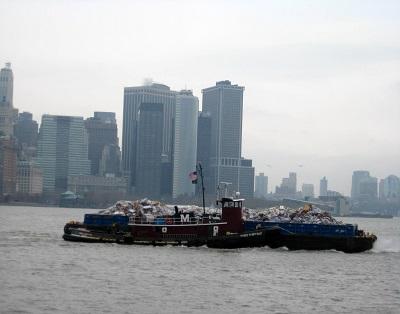 Why is regulating ocean dumping important? How does EPA help protect the ocean?
Why is regulating ocean dumping important? How does EPA help protect the ocean?
Unregulated disposal of wastes and other materials into the ocean degrades marine and natural resources and poses human health risks. For nearly 45 years, EPA’s Ocean Dumping Management Program has stopped many harmful materials from being ocean dumped, worked to limit ocean dumping generally, and worked to prevent adverse impacts to human health, the marine environment, and other legitimate uses of the ocean (e.g., navigation, fishing) from pollution caused by ocean dumping. Learn more about how EPA protects the oceans from dumping in the United States on the Protecting Our Oceans from Pollution Web page.
Besides EPA, what are other federal agencies’ roles with respect to ocean dumping?
Four federal agencies have responsibilities under the MPRSA: EPA, USACE, the National Oceanic and Atmospheric Administration (NOAA) and the U.S. Coast Guard (USCG).
- EPA has primary authority for regulating ocean disposal of all materials except dredged materials.
- USACE and EPA share responsibility for the regulation of dredged material disposal in ocean.
- USCG maintains surveillance of ocean dumping.
- Under Title II of the MPRSA, NOAA is responsible for some long-range research on the effects of human-induced changes to the marine environment.
In addition, EPA’s Ocean Dumping Management Program coordinates with partners at the international, federal, state and local levels, and through interagency groups, including National and Regional Dredging Teams, on ocean dumping, dredged material management, pollution prevention and marine protection activities.
What materials are dumped into the ocean today?
Today, the vast majority of material disposed in the ocean is uncontaminated sediment (dredged material) removed from our nation’s waterways to support a network of coastal ports and harbors for commercial, transportation, national defense and recreational purposes. Other materials disposed in the ocean include human remains for burial at sea, vessels, man-made ice piers in Antarctica, and fish wastes. To find out where vessels have been disposed along with locations of ocean disposal sites, please visit our Ocean Disposal Map.
What materials cannot be dumped in the ocean?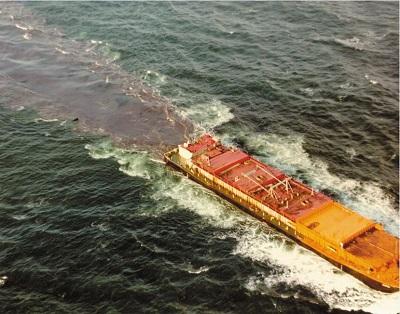
The MPRSA and EPA’s ocean dumping regulations prohibit ocean dumping of certain materials, such as:
- high-level radioactive wastes;
- radiological, chemical and biological warfare agents;
- persistent inert synthetic or natural materials which may float or remain in suspension in the ocean in such a manner that they may interfere materially with fishing navigation or other legitimate uses of the ocean;
- materials insufficiently described to permit application of the environmental impact criteria of 40 CFR 227 subpart B;
- sewage sludge;
- medical wastes;
- industrial wastes, specifically liquid, solid, or semi-solid wastes from a manufacturing or processing plant (except on an emergency basis); and
- materials containing the following constituents in greater than trace amounts (except on an emergency basis):
- Organohalogen compounds.
- Mercury and mercury compounds.
- Cadmium and cadmium compounds.
- Oil of any kind or in any form.
- Known carcinogens, mutagens, or teratogens.
Can wastes be incinerated at sea?
Incineration at sea is considered to be ocean dumping because the emissions from the stack will deposit into the surrounding ocean waters. The Ocean Dumping Ban Act of 1988 banned the dumping of industrial wastes, such as those previously permitted for incineration at sea. In the 1970s and 1980s, several types of liquid organic wastes, including herbicide orange and polychlorinated biphenyls (PCBs), were incinerated at sea using shipboard incinerators. These incineration at sea activities were conducted under MPRSA permits issued by EPA. In 1985, EPA proposed specific regulations to better develop and manage incineration at sea under MPRSA permits, but the regulations were never finalized and the incineration-at-sea program was discontinued in 1988.
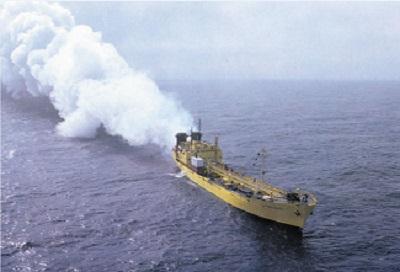 Internationally, incineration at sea is also regulated under the London Convention and London Protocol, which are ocean dumping treaties. The United States is a Contracting Party to the London Convention. The United States has signed the London Protocol, which is intended to modernize and eventually replace the London Convention; however, the Senate has not ratified the treaty.
Internationally, incineration at sea is also regulated under the London Convention and London Protocol, which are ocean dumping treaties. The United States is a Contracting Party to the London Convention. The United States has signed the London Protocol, which is intended to modernize and eventually replace the London Convention; however, the Senate has not ratified the treaty.
Under the London Convention, incineration at sea of industrial waste and sewage sludge is prohibited. The London Convention defines “incineration at sea” as the deliberate combustion of wastes and other matter on marine incineration facilities for the purpose of their thermal destruction. Combustion associated with activities incidental to the normal operation of vessels, platforms and other manmade structures is excluded from the scope of this definition. Marine incineration facility means a vessel, platform, or other manmade structure operating for the purpose of incineration at sea.
Under the London Protocol, incineration at sea and the export of wastes and other materials for incineration at sea is prohibited. The London Protocol defines “incineration at sea” as the combustion on board a vessel, platform or other man-made structure at sea of wastes or other matter for the purpose of their deliberate disposal by thermal destruction. The prohibited incineration at sea does not include the incineration of wastes or other matter on board a vessel, platform, or other man-made structure at sea if such wastes or other material were generated during the normal operation of that vessel, platform, or other manmade structure at sea.
How have ocean protections improved since enactment of the 1972 MPRSA?
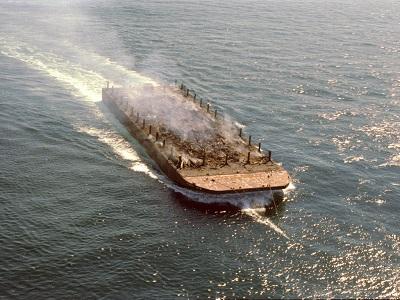 The passage of the MPRSA in 1972 marked a major milestone in the protection of the marine environment. Today, the United States is at the forefront of protecting coastal and ocean waters from adverse impacts due to ocean dumping. The ocean is no longer considered an appropriate disposal location for most wastes. Ocean dumping of certain harmful wastes is banned.
The passage of the MPRSA in 1972 marked a major milestone in the protection of the marine environment. Today, the United States is at the forefront of protecting coastal and ocean waters from adverse impacts due to ocean dumping. The ocean is no longer considered an appropriate disposal location for most wastes. Ocean dumping of certain harmful wastes is banned.
- The Ocean Dumping Ban Act of 1988 amended the MPRSA and now prohibits the ocean dumping of municipal sewage sludge and industrial wastes, such as wastes from plastics and pharmaceutical manufacturing plants and from petrochemical refineries.
- The 1998 amendment also banned the ocean disposal of “medical waste.”
- Other ocean dumping practices, such as wood burning at sea and the disposal of construction and demolition debris, have stopped as a matter of environmentally sound practice.
Those few materials that are ocean dumped are carefully evaluated to ensure that they will not pose a danger to human health or the environment and that there are no better alternatives for their reuse or disposal. The Water Resources Development Act of 1992 amended the MPRSA and now requires that ocean dumping permits, including for ocean disposal of dredged material, conform to long-term management plans to ensure that permitted activities are consistent with expected uses of designated ocean disposal sites. While many challenges remain to protecting and managing our coastal and ocean resources, including historic contamination and continuous degradation from land-based sources, we can be proud of the great strides we have made under the MPRSA.
To learn more, please visit our Ocean Dumping Timeline.
Where can I learn more about EPA’s Ocean Dumping Management Program?
To learn more about the EPA’s Ocean Dumping Management Program, including MPRSA (ocean dumping) permits, ocean disposal sites and international connections, please return to our Ocean Dumping home page.
